Protection against static electricity in everyday life and at the workplace
Every person's daily activity is related to his movement in space. In addition, he not only walks, but also travels by transport.
During each movement, a redistribution of static charges occurs, changing the balance of the internal equilibrium between the atoms and electrons of each substance. It is related to the process of electrification, the formation of static electricity.
In solids, the distribution of charges is due to the movement of electrons, and in liquids and gases, both electrons and charged ions. All of these together make a potential difference.
Causes of static electricity
The most common examples of the manifestation of static forces are explained at school in the first lessons of physics, when they rub glass and ebonite rods on woolen cloth and demonstrate the attraction of small pieces of paper to them.
The experience of deflecting a thin stream of water under the action of static charges concentrated on an ebonite rod is also known.

In everyday life, static electricity manifests itself most often:
-
when wearing woolen or synthetic clothing;
-
walking in rubber-soled shoes or woolen socks on carpets and batum;
-
use of plastic items.

The situation is aggravated by:
-
dry air in the premises;
-
reinforced concrete walls, from which multi-storey buildings are made.
How static is generated
Normally, the physical body contains an equal number of positive and negative particles, which is why a balance is created in it, ensuring its neutral state. When disturbed, the body acquires an electric charge of a certain sign.
Static means a state of rest when the body is not moving. Polarization can occur inside its substance—the movement of charges from one part to another or their transfer from a nearby object.
Electrification of substances occurs due to the acquisition, removal or separation of charges when:
-
interaction of materials due to frictional or rotational forces;
-
sharp drop in temperature;
-
irradiation in different ways;
-
splitting or cutting physical bodies.
Electric charges distributed on the surface of the object or at a distance from it at several interatomic distances. For ungrounded bodies, they spread over the area of the contact layer, and for those connected to the contour of the ground, they flow down to it.
Acquisition of static charges from the body and their draining occur simultaneously. Electrification is provided when the body receives a greater potential of energy than it expends in the external environment.
A practical conclusion follows from this position: to protect the body from static electricity, it is necessary to drain the resulting charges from it to the earth loop.
Static electricity estimation methods
Physical substances, according to their ability to form electric charges of different signs when interacting by friction with other bodies, are characterized on the scale of the triboelectric effect. Some of them are shown in the photo.
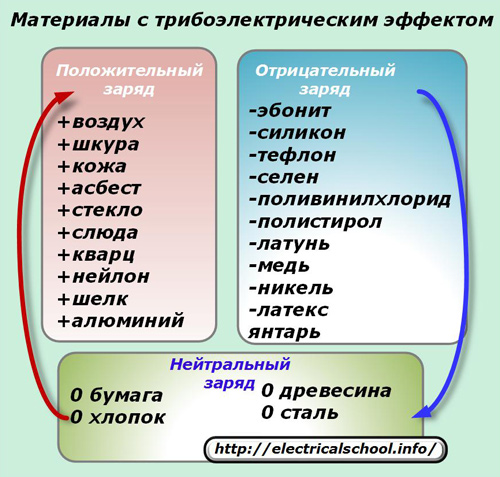
The following facts can be cited as an example of their interaction:
-
walking in woolen socks or shoes with rubber soles on a dry carpet can charge the human body up to 5 ÷ -6 kV;
-
the body of a car moving on a dry road acquires a potential of up to 10 kV;
-
the drive belt that turns the pulley is charged to 25kV.
As you can see, the potential of static electricity reaches very high values even in domestic conditions. But this does not do us much harm, since it does not have much power, and its discharge passes through the high resistance of the contact pads and is measured in milliamperes or a little more.
In addition, it is significantly reduced by air humidity. Its effect on the amount of body stress in contact with different materials is shown in the graph.
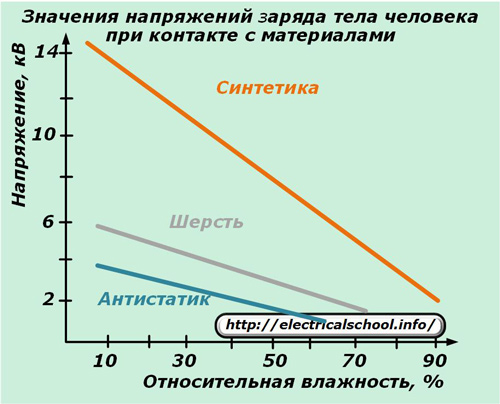
From his analysis follows the conclusion: in a humid environment, static electricity appears less. Therefore, various moisturizers are used to combat it.
In nature, static electricity can be huge.When clouds move over long distances, significant potentials accumulate between them, which are manifested by lightning, the energy of which is enough to split a century-old tree along the trunk or burn down a residential building.
When static electricity discharges in everyday life, we feel the "pinching" of the fingers, see sparks emitted by woolen things, feel a decrease in energy and efficiency. The current to which our body is exposed in everyday life has a negative effect on health, the state of the nervous system, but does not cause obvious, visible damage.
Manufacturers of industrial measuring equipment produce devices that allow you to accurately determine the magnitude of the voltage of accumulated static charges both on equipment boxes and on the human body.
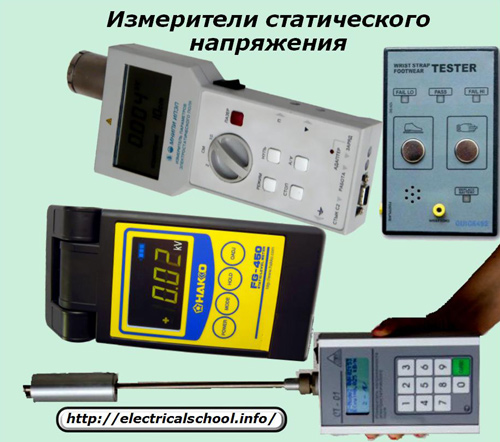
How to protect yourself from static electricity in your home
Each of us should understand the processes that form static discharges that pose a threat to our body. They must be known and limited. For this purpose, various educational activities are carried out, including popular television programs for the population.
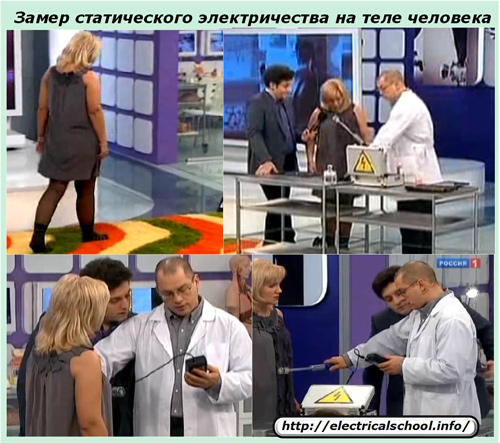
On them, with the help of available means, methods of creating static tension, principles of its measurement and methods of carrying out preventive measures are shown.
For example, considering the triboelectric effect, it is best to use natural wood combs for combing hair, not metal or plastic, as most people do. The wood has neutral properties and does not form charges when rubbed into the hair.

To remove the static potential from the car body when driving on a dry road, special antistatic strips attached to the bottom are used. Various types of these are widely available for sale.
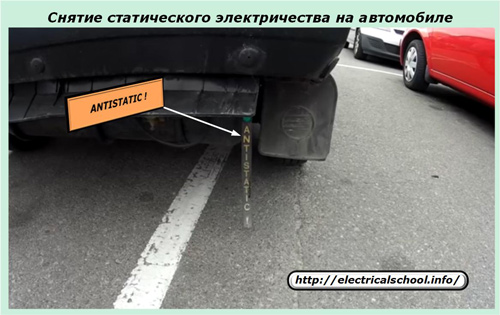
If there is no such protection on the car, then the voltage potential can be removed by short-term grounding of the case using a metal object, for example a car ignition key. It is especially important to follow this procedure before refueling.
When a static charge accumulates on clothes made of synthetic materials, it can be removed by treating steam from a special container with an antistatic composition. In general, it is better to use less such fabrics and wear natural materials such as linen or cotton.
Rubber-soled shoes also help build up charge. It is enough to put in it antistatic insoles made of natural materials, as the harmful effect on the body will be reduced.
The influence of the dry air characteristic of urban apartments in winter has already been discussed. Special humidifiers or even small pieces of moistened cloth placed on household items improve the environment and reduce the formation of static electricity. But regular wet cleaning indoors allows you to remove electrified particles and dust in a timely manner. This is one of the best ways to protect yourself.
Household electrical appliances also accumulate static charges on the box during operation. The equipotential bonding system connected to the common ground of the building circuit is designed to reduce their impact.Even a simple acrylic bathtub or an old cast iron structure with the same insert is subject to static action and must be protected in this way.
How is protection against static electricity carried out in production?
Factors that reduce the performance of electronic equipment
Discharges generated in the manufacture of semiconductor materials can cause great harm, disrupt the electrical characteristics of devices or even disable them completely.
In production settings, disposal can be arbitrary and depend on a number of different factors:
-
the values of the received capacity;
-
energy potential;
-
electrical resistance of the contacts;
-
type of transients;
-
other accidents.
In this case, at the initial time on the order of ten nanoseconds, the discharge current increases to a maximum and then decreases within 100–300 ns.
The nature of the occurrence of static discharge on a semiconductor device through the operator's body is shown in the photo.
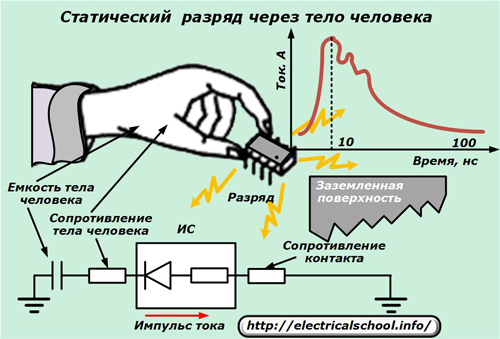
The magnitude of the current is affected by: the capacity of the charge accumulated by a person, the resistance of his body and the contact pads.
In the manufacture of electrical equipment, static discharge can be created without operator intervention due to the formation of contacts through grounded surfaces.
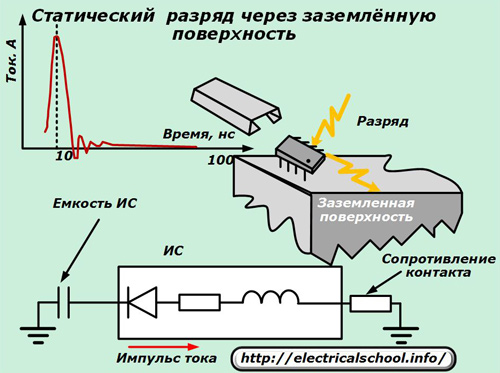
In this case, the discharge current is affected by the charge capacity accumulated by the device case and the resistance of the formed contact pads. In this case, the induced high voltage potential and the discharge current simultaneously affect the semiconductor at the initial instant.
Due to such a complex effect, the damage can be:
1.specifically, when the performance of the elements is reduced to such an extent that they become unusable;
2. hidden — by reducing the output parameters, sometimes even falling within the established factory characteristics.
The second type of malfunctions is difficult to detect: they most often affect the loss of productivity during work.
An example of such damage from the action of high static voltage is shown by the deviation plots of the volt-ampere characteristics applied to the diode KD522D and the integrated circuit KR1005VI1 LSI.
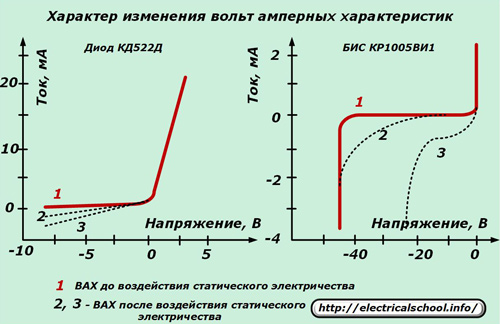
The brown line number 1 shows the parameters of the semiconductor devices before the tests with increased voltage, and the curves number 2 and 3 show their reduction under the influence of the increased induced potential. In case #3, it has a bigger impact.
Damage can be caused by actions by:
-
overestimated induced voltage that breaks the dielectric layer of semiconductor devices or breaks the crystal structure;
-
high current density causing high temperature leading to melting of materials and burning of the oxide layer;
-
tests, electrical thermal training.
Latent damage can affect work not immediately, but after several months or even years of work.
Methods of performing ESD protection in production
Depending on the type of industrial equipment, one of the following methods of maintaining operability or their combination is used:
1. eliminating the formation of electrostatic charges;
2. blocking their entry to the workplace;
3. increasing the resistance of devices and accessories to the action of discharges.
Methods # 1 and # 2 allow you to protect a large group of different devices in a complex, and # 3 is used for individual devices.
High efficiency in maintaining the operability of the equipment is achieved by placing it in a Faraday cage, a space surrounded on all sides by a fine mesh of metal mesh connected to the ground loop. External electric fields do not penetrate inside it and it has a static magnet.
Shielded cables work on this principle.
Protection against static action is classified according to the implementation principles of:
-
physical and mechanical;
-
chemical;
-
constructively and technologically.
The first two methods allow you to prevent or reduce the formation of static charges and increase the speed of their drainage. The third method protects devices from the effects of charges, but does not affect their draining.
You can improve waste drainage by:
-
creating a crown;
-
increasing the conductivity of materials on which charges accumulate.
Solve these problems:
-
air ionization;
-
increase in working surfaces;
-
selection of materials with the best volumetric conductivity.
Thanks to their implementation, pre-prepared highways are created to lead static charges to the ground circuit, excluding their impact on the working elements of the devices. In this case, it is taken into account that the total electrical resistance of the created path should not exceed 10 ohms.
If the materials have great resistance, then protection is done in other ways. Otherwise, charges begin to accumulate on the surface, which can be discharged upon contact with the ground.
An example of the implementation of complex electrostatic protection in the workplace for an operator engaged in the maintenance and adjustment of electronic devices is shown in the photo.
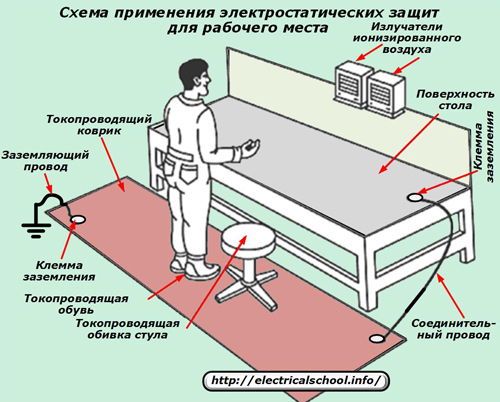
The surface of the table is connected to the ground loop by a connecting wire and a conductive pad using special terminals. The operator works in special clothing, wears shoes with conductive soles and sits in a chair with a special seat. All these measures make it possible to effectively dispose of the accumulated charges on the ground.
Working air ionizers regulate humidity, reduce the potential of static electricity. When using them, it is taken into account that the increased content of water vapor in the air adversely affects human health. So they try to keep it at around 40%.
Also, an effective way can be the regular ventilation of the room or the use of a ventilation system in it, when the air passes through the filters, ionizes and mixes, thereby ensuring the neutralization of the resulting charges.
To reduce the potential built up by the human body, bracelets can be used to complement the set of antistatic clothing and shoes. They consist of a conductive band that is attached to the shoulder with a buckle. The latter is connected to the ground wire.
With this method, the current flowing through the human body is limited. Its value should not exceed one milliamp. Larger values may cause pain and electrical injury.
During the discharge of the charge to the ground, it is important to ensure the rate of its discharge in one second.Floor coverings with low electrical resistance are used for this purpose.
When working with semiconductor boards and electronic components, protection against damage from static electricity is also provided:
-
forced bypassing of the terminals of electronic boards and blocks during inspections;
-
using tools and soldering irons with grounded working heads.
Containers of flammable liquids located on vehicles are earthed with a metal chain. Even the plane's fuselage is equipped with metal cables that work as protection against static electricity during landing.
